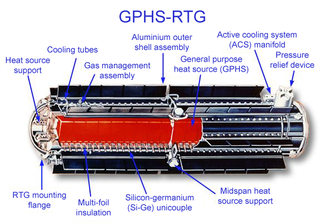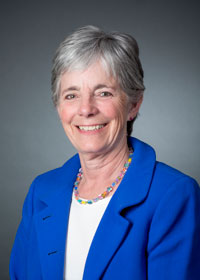The National Institute of Standards and Technology (NIST) is an agency of the United States Department of Commerce whose mission is to promote American innovation and industrial competitiveness. NIST's activities are organized into physical science laboratory programs that include nanoscale science and technology, engineering, information technology, neutron research, material measurement, and physical measurement. From 1901 to 1988, the agency was named the National Bureau of Standards.

A nuclear reactor is a device used to initiate and control a fission nuclear chain reaction or nuclear fusion reactions. Nuclear reactors are used at nuclear power plants for electricity generation and in nuclear marine propulsion. Heat from nuclear fission is passed to a working fluid, which in turn runs through steam turbines. These either drive a ship's propellers or turn electrical generators' shafts. Nuclear generated steam in principle can be used for industrial process heat or for district heating. Some reactors are used to produce isotopes for medical and industrial use, or for production of weapons-grade plutonium. As of 2022, the International Atomic Energy Agency reports there are 422 nuclear power reactors and 223 nuclear research reactors in operation around the world.

Oak Ridge National Laboratory (ORNL) is a federally funded research and development center in Oak Ridge, Tennessee, United States. Founded in 1943, the laboratory is now sponsored by the United States Department of Energy and administered by UT–Battelle, LLC.

A pressurized water reactor (PWR) is a type of light-water nuclear reactor. PWRs constitute the large majority of the world's nuclear power plants. In a PWR, the primary coolant (water) is pumped under high pressure to the reactor core where it is heated by the energy released by the fission of atoms. The heated, high pressure water then flows to a steam generator, where it transfers its thermal energy to lower pressure water of a secondary system where steam is generated. The steam then drives turbines, which spin an electric generator. In contrast to a boiling water reactor (BWR), pressure in the primary coolant loop prevents the water from boiling within the reactor. All light-water reactors use ordinary water as both coolant and neutron moderator. Most use anywhere from two to four vertically mounted steam generators; VVER reactors use horizontal steam generators.

Sandia National Laboratories (SNL), also known as Sandia, is one of three research and development laboratories of the United States Department of Energy's National Nuclear Security Administration (NNSA). Headquartered in Kirtland Air Force Base in Albuquerque, New Mexico, it has a second principal facility next to Lawrence Livermore National Laboratory in Livermore, California, and a test facility in Waimea, Kauai, Hawaii. Sandia is owned by the U.S. federal government but privately managed and operated by National Technology and Engineering Solutions of Sandia, a wholly owned subsidiary of Honeywell International.

A radioisotope thermoelectric generator, sometimes referred to as a radioisotope power system (RPS), is a type of nuclear battery that uses an array of thermocouples to convert the heat released by the decay of a suitable radioactive material into electricity by the Seebeck effect. This type of generator has no moving parts and is ideal for deployment in remote and harsh environments for extended periods with no risk of parts wearing out or malfunctioning.

Neutron generators are neutron source devices which contain compact linear particle accelerators and that produce neutrons by fusing isotopes of hydrogen together. The fusion reactions take place in these devices by accelerating either deuterium, tritium, or a mixture of these two isotopes into a metal hydride target which also contains deuterium, tritium or a mixture of these isotopes. Fusion of deuterium atoms results in the formation of a helium-3 ion and a neutron with a kinetic energy of approximately 2.5 MeV. Fusion of a deuterium and a tritium atom results in the formation of a helium-4 ion and a neutron with a kinetic energy of approximately 14.1 MeV. Neutron generators have applications in medicine, security, and materials analysis.

The United States Department of Energy National Laboratories and Technology Centers is a system of laboratories overseen by the United States Department of Energy (DOE) for scientific and technological research. The primary mission of the DOE national laboratories is to conduct research and development (R&D) addressing national priorities: energy and climate, the environment, national security, and health. Sixteen of the seventeen DOE national laboratories are federally funded research and development centers administered, managed, operated and staffed by private-sector organizations under management and operating (M&O) contracts with the DOE.

The Z Pulsed Power Facility, informally known as the Z machine or Z, is the largest high frequency electromagnetic wave generator in the world and is designed to test materials in conditions of extreme temperature and pressure. It was originally called the PBFA-II and was created in 1985. Since its refurbishment in October 1996 it has been used primarily as an inertial confinement fusion (ICF) research facility. Operated by Sandia National Laboratories in Albuquerque, New Mexico, it gathers data to aid in computer modeling of nuclear weapons and eventual fusion pulsed power plants.
Pyroelectric fusion refers to the technique of using pyroelectric crystals to generate high strength electrostatic fields to accelerate deuterium ions (tritium might also be used someday) into a metal hydride target also containing deuterium (or tritium) with sufficient kinetic energy to cause these ions to undergo nuclear fusion. It was reported in April 2005 by a team at UCLA. The scientists used a pyroelectric crystal heated from −34 to 7 °C (−29 to 45 °F), combined with a tungsten needle to produce an electric field of about 25 gigavolts per meter to ionize and accelerate deuterium nuclei into an erbium deuteride target. Though the energy of the deuterium ions generated by the crystal has not been directly measured, the authors used 100 keV (a temperature of about 109 K) as an estimate in their modeling. At these energy levels, two deuterium nuclei can fuse to produce a helium-3 nucleus, a 2.45 MeV neutron and bremsstrahlung. Although it makes a useful neutron generator, the apparatus is not intended for power generation since it requires far more energy than it produces.

Nuclear fuel is material used in nuclear power stations to produce heat to power turbines. Heat is created when nuclear fuel undergoes nuclear fission.

The supercritical water reactor (SCWR) is a concept Generation IV reactor, designed as a light water reactor (LWR) that operates at supercritical pressure. The term critical in this context refers to the critical point of water, and should not be confused with the concept of criticality of the nuclear reactor.

The lead-cooled fast reactor is a nuclear reactor design that use molten lead or lead-bismuth eutectic coolant. These materials can be used as the primary coolant because they have low neutron absorption and relatively low melting points. Neutrons are slowed less by interaction with these heavy nuclei so these reactors operate with fast neutrons.

Carolinas–Virginia Tube Reactor (CVTR), also known as Parr Nuclear Station, was an experimental pressurized tube heavy water nuclear power reactor at Parr, South Carolina in Fairfield County. It was built and operated by the Carolinas Virginia Nuclear Power Associates. CVTR was a small test reactor, capable of generating 17 megawatts of electricity. It was officially commissioned in December 1963 and left service in January 1967.
The Neutron Science Laboratory (NSL) is situated within the North Campus of the University of Michigan and houses various neutron and gamma-ray sources and a range of nuclear radiation detection equipment. The laboratory is an integral part of Nuclear Engineering and Radiological Sciences (NERS) department at the University of Michigan (U-M) and is managed by the Applied Nuclear Science Group. The laboratory was renovated in 2017 with a specific goal to accommodate the use of a new DT neutron generator in various open-beam configurations. NSL provides convenient access to high-fidelity monoenergetic and broad-energy neutron sources for basic research, nuclear security and nonproliferation, and other experimental needs.
A linear transformer driver (LTD) within physics and energy, is an annular parallel connection of switches and capacitors. The driver is designed to deliver rapid high power pulses. The LTD was invented at the Institute of High Current Electronics (IHCE) in Tomsk, Russia. The LTD is capable of producing high current pulses, up to 1 mega amps (106 ampere), with a risetime of less than 100 ns. This is an improvement over Marx generator based pulsed power devices which require pulse compression to achieve such fast risetimes. It is being considered as a driver for z-pinch based inertial confinement fusion.

The 1961 Goldsboro B-52 crash was an accident that occurred near Goldsboro, North Carolina, United States, on 24 January 1961. A Boeing B-52 Stratofortress carrying two 3.8-megaton Mark 39 nuclear bombs broke up in mid-air, dropping its nuclear payload in the process. The pilot in command, Walter Scott Tulloch, ordered the crew to eject at 9,000 ft (2,700 m). Five crewmen successfully ejected or bailed out of the aircraft and landed safely; another ejected, but did not survive the landing, and two died in the crash. Information declassified since 2013 has showed that one of the bombs was judged by nuclear weapons engineers at the time to have been only one safety switch away from detonation, and that it was "credible" to imagine conditions under which it could have detonated.

ATLAS-I, better known as Trestle, was a unique electromagnetic pulse (EMP) generation and testing apparatus built between 1972 and 1980 during the Cold War at Sandia National Laboratories near Kirtland Air Force Base in Albuquerque, New Mexico.

Operated by Sandia National Laboratories for the U.S. Department of Energy (DOE), the National Solar Thermal Test Facility (NSTTF) is the only test facility of this type in the United States. The NSTTF’s primary goal is to provide experimental engineering data for the design, construction, and operation of unique components and systems in proposed solar thermal electrical plants planned for large-scale power generation.

Susan Joyce Seestrom is an American experimental nuclear physicist and physics administrator, the Chief Research Officer at Sandia National Laboratories. Before moving to Sandia, she was the first female head of the Physics Division and the Weapons Physics Directorate at the Los Alamos National Laboratory, and she became the first female chair of the Nuclear Science Advisory Committee of the Department of Energy and National Science Foundation. She is known for her research on neutrons and particularly on ultracold neutrons.
















